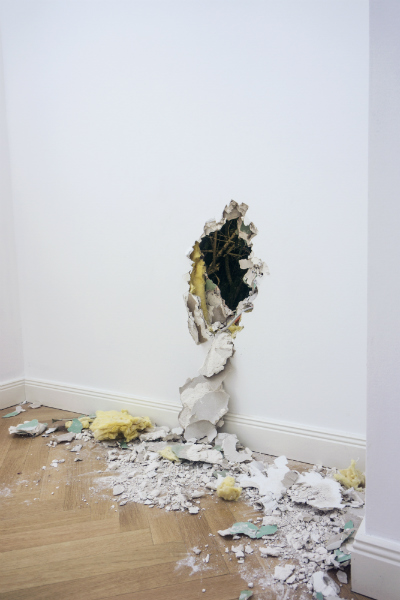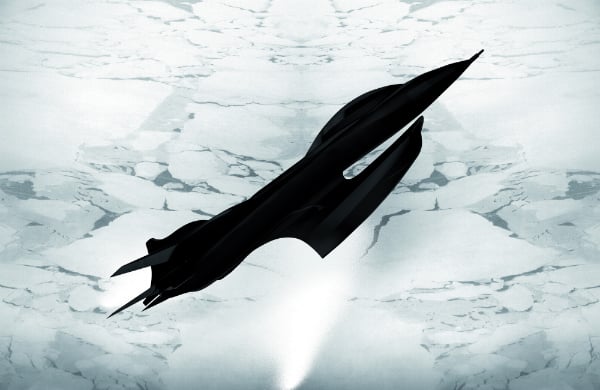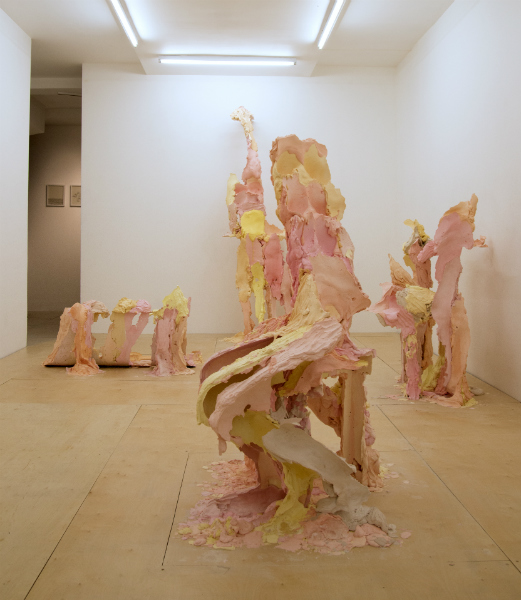Reviews
The 5th Moscow Biennale for Young Art Signals Millennials’ Deepest Anxieties
The fears are not generation-specific but this expression of them is.

The fears are not generation-specific but this expression of them is.

Hettie Judah

Under the ominous title “Deep Inside,” the 5th Moscow International Biennale for Young Art offers a view into the abyss—courtesy not only of its participating artists, but also its central venue’s labyrinth of precarious and barely lit corridors.
The Trekhgornaya Manufaktura, an imposing nineteenth century textile factory, has lent its name to a post-industrial district populated by start-ups, cafes, and cultural organizations. The building itself remains unrenovated. Perfect for interventions like Alvaro Urbano’s untitled work in which a smashed portion of the wall offers a view into a loam-scented woodland in the space beyond. Not so great for those negotiating the stygian gloom in open sandals—during the vernissage the yelp of regularly stubbed toes was just audible over the insistent soundtracks of competing video installations.

Alvaro Urbano, untitled (2016). Courtesy of the 5th Moscow International Biennale for Young Art
Writing this from England, a country where an attempt to play Erik Satie’s Vexations through to the prescribed 840 repetitions was foiled by municipal fire regulations, one feels duty bound to condemn health and safety restrictions to the squares. But the not-young and pain shy among us might do better to shuffle off to a Biennial for the Art of Helicopter Parenting or International Exhibition of Nonspecific Aches or somesuch.
The gloom was not always to the art’s advantage either though. Entering through Marguerite Humeau’s spectacular installation The Things? – A Trip to Europa, (2013)—in which a dirigible black jet suspended centimeters off crash point is visible only via irregular strobe lighting—it took three visits to the space to find one of the two other works exhibited in it (Steve Maher’s Heavy Metal Detector 2.0, a contemporary security device shaped like a broadsword that purportedly played heavy metal music when triggered).

Marguerite Humeau The Things? – A Trip to Europa, (2013). Courtesy of the 5th Moscow International Biennale for Young Art
As per the selected works, which include Google Earth views of sites linked to the morphing data industry courtesy Ivar Veermae’s Center of Doubt, (2015), and a landscape portrait of DR Congo rendered in its own rare metals by Revital Cohen & Tuur Van Balen (Too Good To Be True, 2016) the depth alluded to in the exhibition title signals a kind of lingering threat embodied in the deep web, deep state, or fathoms plumbed in mining for natural resources.
It also seems a catch-all for a general sense among Millennials that the whole world is being dragged into the abyss faster than you can generate a “You Shall Not Pass!” meme. The entire building reverberates with a noise that one can only characterize as digital unease: a soundscape generated by multiple otherwise-unrelated works rather than any one in particular. Such anxiety is not generation-specific—in the 80s and 1990s we had mutually assured destruction and “the whole world is dying of panicky fright”—but this expression of it perhaps is, hence the logic in selecting young curators (in this case Nadim Samman) to assemble exhibitions of their peers rather than dusty elders who might find the work less compelling.

Juliana Cerqueira Leite, Three Dances, (2016). Courtesy of the 5th Moscow International Biennale for Young Art
Still, highlights of the main show came in those projects little connected to the theme. Juliana Cerqueira Leite’s Three Dances, (2016) was a plaster cast freeze frame of the artist’s own body in various interconnected dance positions. Julius Von Bismarck’s Landscape Painting (Russia), (2015) is a composite photograph of a rural scene painted white, from the pebbles to the treetops, then recolored from memory by locals. Both were technically and conceptually beguiling.
Within this non-specific desert of the real, a rare hint of engagement with recent events comes courtesy of Yuria Spiridonova who each day juxtaposes materials pertaining to two news feeds, one relating to world news, the other disseminated by Moscow’s botanical garden. Handwritten in Cyrillic, the first entry carries the appendix “#brexit #brexit #brexit.”
There was some strong work here, but overall the experience felt scattershot: even prior to reading confirmation of such in the main show’s catalog, a gulf between stated intent and the art present suggested a selection process based on submitted proposals rather than first hand experience of the work.

Patrick Hough, Object Interviews (Part II) (2013). Courtesy of the artist and narrative
projects, London.
The Biennial’s two “strategic projects,” by contrast, were coherent and well paced. João Laia’s “H Y P E R C O N N E C T E D” used each of the multiple levels at the Moscow Museum of Modern art to explore an interlinked theme, notably showing multiple works by many of the artists. This allowed for something approaching meaningful insight into the artists’ investigation of particular ideas and themes (this change of pace was also essayed in Manifesta 11’s co-curated historical exhibition, albeit on an overwhelming scale—trendwatchers take note.)
Thus we found Mariana Silva’s Friends of Impenetrable Objects (2013), a project shown in two distinct audiovisual works that investigated 3D mapping of historical objects and sites, and the politics of on-site precarity vs colonial theft, vandalism and “backup copies,” in relation to the Elgin Marbles and Palmyra. The three films of Patrick Hough’s Object Interviews (2013-16) focus on a pair of “Egyptian” film props and the readings given of them by an Egyptologist, a cultural theorist, and professional prop makers, destabilizing ideas of object authenticity and aura.
In an elegant aesthetic coup, the airy final floor was one of post-corporeal futurism, dominated by Neringa Černiauskaitė’s Lost Heritage (2015) in which hybrid flora/fauna in tones of sticky membrane sprout from squares of damp turf and a crop sprayer mists the space with toxic-toned pink clouds.

Adrien Missika, Darvaza. Courtesy of Galerie Bugada & Cargnel
At the National Centre for Contemporary Arts, Silvia Franceschini and Valeria Mancinelli present the pithy “Time of Reasonable Doubts.” Academic Sophia Gräfe shares extraordinary GDR-era film footage of the Stasi being trained in covert film making—non art it may be, but it’s a heck of a way to kick off a show.
Meriç Algün Ringborg documents all 136 photographs in which she accidentally appears over the course of a year—a reminder that it is omnipresent private cameras rather than tools of the state that now surveil us. In Basma Alsharif’s The Story of Milk and Honey (2011) the generic and the particular of love and love stories meld in an impossible attempt to tell a story of the making of a film of a story. Totemic of the show overall, the veracity of official and artistic representation is questioned and any sense of an authoritative version of events—personal or historical—is undermined. More simply put: don’t trust what you see. Or read.
The Moscow Biennial for Young Art runs thru 10 August